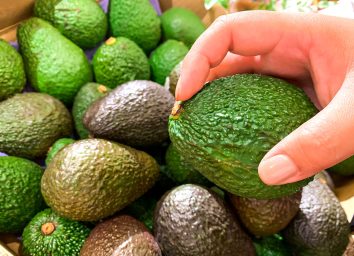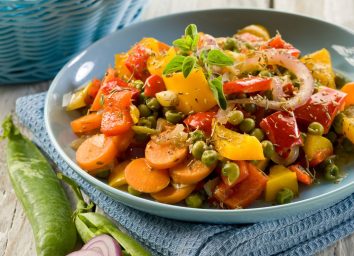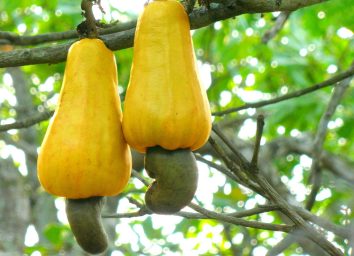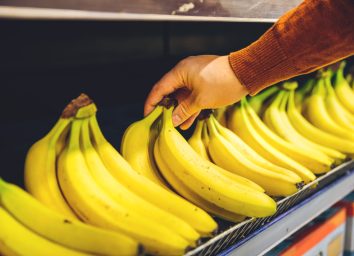How to Safely Wash Fruits and Vegetables During the Coronavirus Pandemic
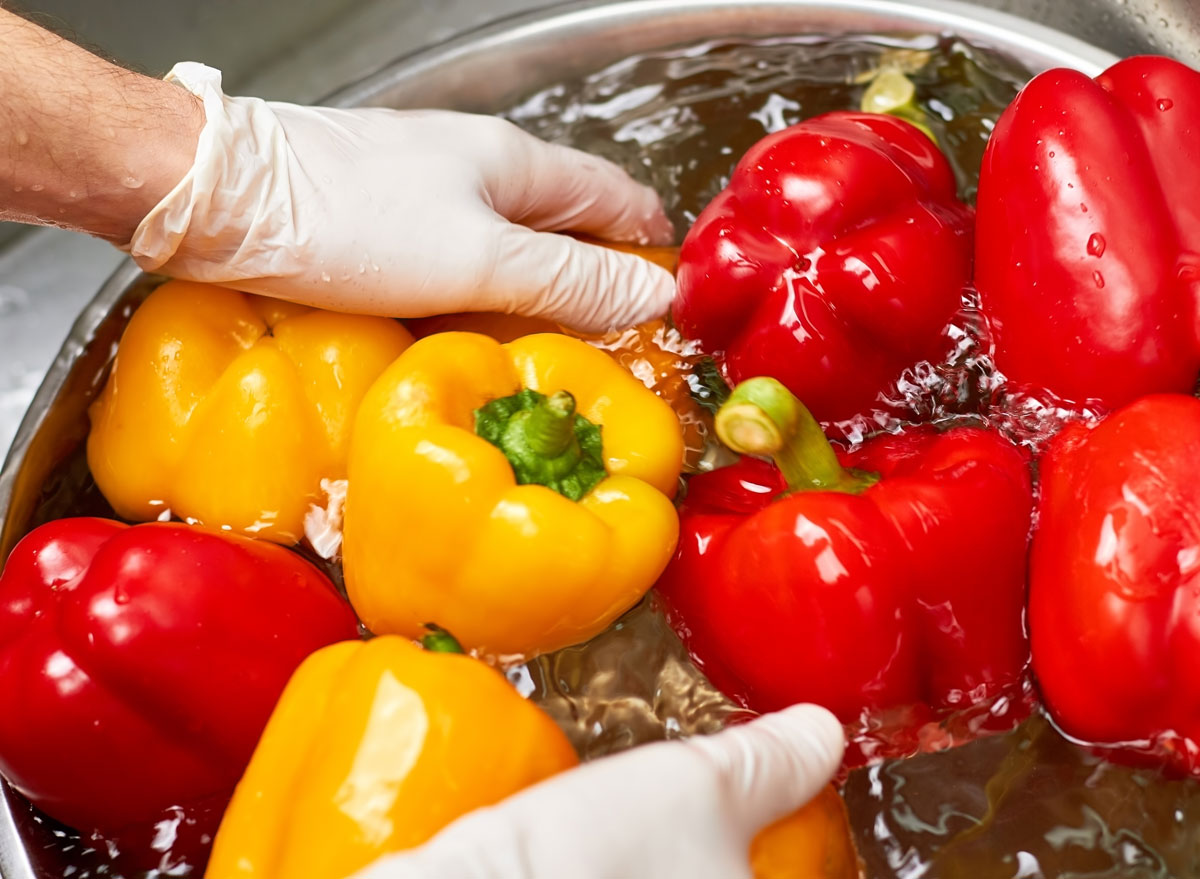
Washing produce is always important, but given the current coronavirus pandemic, ensuring your food is clean and safe to consume is more crucial now than ever before.
Plenty of produce (cucumbers, peaches, peppers, and more) often just sits out on supermarket shelves without any added protection. Knowing that coronavirus can be transmitted via direct contact, you might be thinking twice about reaching for some fresh fruit. Even though scientists have found that COVID-19 can't live on surfaces for very long, including on produce, are you really eager to bring home an apple that dozens of others may have touched without cleaning it properly before you snack away? Pandemic or not, the answer is probably no.
That's why we talked to a team of dietitians, nutritionists, and food safety experts to find out how to wash vegetables and fruit properly. These pros guided us through everything from why it is necessary to follow coronavirus food safety guidelines, always clean your produce, the best ways to wash different types of produce, and extra steps you can take to protect yourselves and your loved ones as the COVID-19 crisis continues.
Why is it important to wash your produce?
You should wash your produce, whether society is in the throes of a pandemic or not. Because produce goes through several steps to get to your kitchen (harvesting, packaging, shipping, being placed on shelves in grocery store, you putting it in your cart), it's important to make sure it's as clean as can be. After all, you don't know where that lettuce in your salad has been or what it has touched. Plus, consuming unwashed produce could increase your chances of contracting a foodborne illness.
"Produce can become contaminated from the growth phase where it may be exposed to contamination from the soil, animals or humans to when it's purchased and stored," says Susan Piergeorge, MS, RDN, a registered dietitian nutritionist for Rainbow Light and Natural Vitality CALM who cites Glenda Lewis, an expert on foodborne illness with the U.S Food and Drug Administration. "Produce may harbor microorganisms (such as bacteria or fungus), as well as trace amounts of chemicals."
Foodborne illnesses aside, the pesticides used to keep bugs and insects away from our food while it grows can also be damaging in their own right. "Today, farming has advanced, and the usage of chemicals such as pesticides to get a better yield has increased," says Caroline Bricout, who works with, the ultrasonic vegetable cleaner, Sonic Soak. "However, pesticides and other chemicals used in farming have taken a toll on produce quality and eventually, people's health."
Bricout points out that pesticides may be linked to cancer. In fact, a 2011 summary of various studies in the Official Publication of the College of Family Physicians of Canada found that most studies on non-Hodgkin lymphoma and leukemia showed positive associations with pesticide exposure. The literature also showed positive associations between pesticide exposure and solid tumors.
As Bricout says, "It's always good to wash your food."
What's the best way to wash your produce?
Believe it or not, washing your produce properly isn't all that different from washing your hands at the end of the day. "You can wash your food thoroughly the same way the government recommends to wash your hands (with a 20 second minimum), or you can use an ultrasonic cleaner that is, without any doubt the most efficient way of cleaning your food," says Bricout.
Still, while items such as ultrasonic cleaner or vegetable washes may give you a certain peace of mind (especially in uncertain times like these) experts say they aren't necessary. "Washing produce does not need to include any specific detergent or fancy vegetable wash according to the Food and Drug Administration," says Shaw. "Simply use running water to help 'wash' the produce."
Below are some additional produce-cleaning tips:
- Wash your hands first: As Rachel Berman, RD and general manager of Verywell points out, it's crucial to make sure your hands are clean first before you put your paws on your produce. "Before washing produce, make sure to wash your hands well with soap and water, as we all should be doing anyway right now," she says.
- Remove bruised or damaged portions of your produce: Piergeorge points out, per the FDA, that choosing produce that isn't damaged or bruised is crucial. "And make sure that pre-cut items—such as bags of lettuce or watermelon slices—are either refrigerated or on ice both in the store and at home," she says. "If damage or bruising occurs before eating or handling, cut away the damaged or bruised areas before preparing or eating."
- Keep an eye on packaged produce: "While most pre-packaged produce is usually clean, the one issue with pre-packaged produce (i.e. bunch of apples in a pack) is that you may have a hard time seeing if there is any mold or severe bruises on any of the produce in the bag before purchasing it," says Amanda A. Kostro Miller, RD, LDN, who serves on the advisory board for Fitter Living. "So, when possible, try to choose individual produce so that you can pick the best produce in the bunch."
- Wash your produce just before eating or cooking it: "Generally, to prevent foodborne illnesses from bacteria, people should rinse and scrub their produce under a running tap immediately before eating or cooking," Berman says. "Washing and storing wet produce creates an environment where more bacteria can grow. If the fruit or veggie contains an inedible skin, make sure to rinse it well before peeling or cutting to prevent the bacteria from moving into the flesh that you do eat."
- Give your produce a shower: According to Miller, consumers should liken washing their produce to giving it a "shower" of sorts. "Do not fill up your sink to let the produce soak in the water," she says. "Keep the tap running and give your produce a nice cool shower, rather than a bath."
- Beware the drain: "A clean bowl may be better than a sink, as the drain area may have more microorganisms present," Piergeorge says, citing a study from Colorado State University Extension.
- Skip the soap: "Rinsing with light scrubbing (no soap) can also help remove dirt or bacteria that we do not want to contaminate the inside of the produce when we cut into it," Miller says.
Miller also notes that washing produce under cool tap water before consumption or cooking addresses many of the concerns raised above. "First, rinsing with water can help remove some pesticide residue that may be on the produce. Most pesticide use is regulated by the EPA, and the amount of pesticide that transfers to our produce when we buy it is within the safety limits from the EPA." she says.
What about produce that has been pre-washed?
When it comes to fruits and veggies that are labeled as "pre-washed," our experts were split. "As far as washing the pre-washed, it depends on who you ask," says Piergeorge.
The arguments for washing pre-washed vegetables and fruit:
"Sometimes produce can become contaminated by how one touches, washes and prepares and stores it. Some evidence reveals the pre-washed produce may have less contamination compared to produce that has not been pre-washed. Cooking can also destroy a number of microorganisms but not all of them."
As Berman says, "Prewashed isn't a regulated claim by the FDA, so you're better off rinsing to be safe." And San Diego-based nutrition expert Elizabeth Shaw, MS, RDN, CPT, who is also an author and owner of Shaw's Simple Swaps agrees.
"Taking proper food safety precautions with your produce is always a great idea, regardless of what the packaging says. There are many different steps in the production of pre-washed and pre-cut products, meaning multiple areas where potential food safety issues can come into play. While many organizations and companies have great processes and procedures in place, these products are always subject to human error (as well as environmental concerns,)" says Shaw.
The arguments against washing pre-washed vegetables and fruit:
Still, there are those that disagree. "The FDA advises against washing pre-washed or triple washed bags of ready-to-eat produce (like spinach or lettuce). This is because at home you have a higher risk of contaminating the food," says Toby Amidor, MS, RD, CDN, FAND and author of The Best Rotisserie Chicken Cookbook. "I have visited several facilities where they pre-wash lettuce and the guidelines are extremely strict and regulated (probably more clean than most kitchens!). If you do choose to wash produce that is labelled as 'pre-washed' or 'ready-to-eat' then make sure to avoid contact with unclean surfaces in order to avoid cross-contamination."
Miller says, "For greens that are labeled as 'pre-washed' or 'ready-to-eat,' do not wash these items because washing will not improve their cleanliness. Plus, any added moisture can cause wilting or microbial growth."
Do some fruits and vegetables need to be washed differently or more thoroughly than others?
Generally speaking, washing all produce using the methods and tips above is enough to keep you safe. As Bricout puts it: "All greens and veggies should be washed thoroughly, regardless of their shape."
Miller says: "According to the Academy of Nutrition and Dietetics, all produce should be washed, even with edible or inedible peels." Produce with edible peels includes apples, peaches and grapes, while produce with inedible peels includes bananas, avocados and oranges.
"Whatever is on the skin of the produce can be pushed into the pulp of the produce when we start cutting into it with a knife or peeling it with our fingers (in the case of an orange for example," Miller says.
Exactly how to wash the most common fruits and vegetables.
Here are some food-specific tips you can keep in mind:
- Apples: "You don't need to scrub smoother produce skins (i.e. apples) if you are able to rinse off all parts of the fruit," says Miller.
- Fresh herbs: "All fresh herbs should be washed and wrapped in paper towels," says Kate Lacroix, the owner of a pantry-building service called Stocked.
- Grapes and strawberries: Miller notes that smaller produce has its own set of rules. "For produce that is small like strawberries or grapes, place the berries in a colander and rinse under running water," she says. "Be sure to let berries/grapes dry. It is also important to dry the produce after washing so that all water is removed and moisture does not get caught within the produce. Dry produce with a clean cloth before properly storing it."
- Leafy greens: "For leafy greens and produce like cabbage with outer leaves, it's recommended to discard (or compost) the outer leaves and submerge the produce in the cool water, then rinse," says Shaw.
- Melons, cantaloupe and pineapple: For textured fruit such as this, Miller says "scrubbing with a produce brush is particularly important."
- Root vegetables: Shaw says, "For potatoes and other root vegetables, you can use a scrub brush designated for produce to help get the dirt and debris out with water."
- Spinach (and other loose leaves): "Loose leaves that are not pre-washed can be placed in a bowl of cold water (or salad spinner), spun around for 30 seconds, drained and then re-rinsed and re-spun once more (for a total of two cycles) before drying and cooking," Miller says.
What extra precautions should you take in light of the COVID-19 pandemic?
Again, the information we've provided thus far is more than enough to ensure your produce of all kinds is safe to consume. However, if you're feeling a bit anxious in light of the current coronavirus pandemic, there are some extra tips that might be helpful to keep in mind. (And cleansing produce with bleach or any other detergent is definitely not one of them.)
- Use gloves. "The safest thing you can do in the age of coronavirus is to use gloves to unwrap and throw away packaging immediately," says Lacroix. "The incidence of catching COVID-19 from food is very low but giving everything a rinse is a good way to ensure you are doing what you can to stay healthy."
- Clean your kitchen. Miller notes that cleaning your kitchen and specific food prep areas (in addition to your own hands) is also key to warding off any unwanted germs. "Make sure you disinfect your countertops before placing your produce on the counter," says Miller. "Also, be wary of your faucet and make sure to disinfect the knobs/nozzle. You might come home, turn the faucet on with dirty hands and then turn it off with clean hands after washing. Then, you might turn the knob again to wash your produce, potentially coming in contact with bacteria or viruses on the knobs."
- Wash your hands. "Rinsing your produce is important, but washing your hands when handling food is even more important. In light of coronavirus, make sure you wash your hands with soap and water before handling your food and before washing produce," she says.
- Cook all produce. "If you are more concerned, consider cooking your produce via steam, roasting, or pressure cooking to help kill off bacteria as well," Shaw says.
Still, Amidor points out that these extra steps likely won't have much of an impact given the nature of the virus. "In terms of COVID-19, there is no evidence that fresh produce (or any other food, or other product/material) can transmit the virus," she says.
"However, like other viruses, it is possible that the virus that causes COVID-19 can survive on surfaces or objects and that is why it is important to follow the four key steps of food safety which include clean, separate, cook, and chill."
